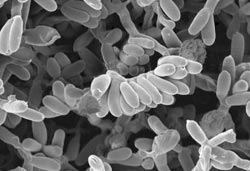New way to improve antibiotic production

The antibiotic planosporicin is produced by a soil bacterium called Planomonospora alba.<br><br>Credit: John Innes Centre<br>
An antibiotic has been found to stimulate its own production. The findings, to be published in PNAS, could make it easier to scale up antibiotic production for commercialisation.
Scientists Dr Emma Sherwood and Professor Mervyn Bibb from the John Innes Centre were able to use their discovery of how the antibiotic is naturally produced to markedly increase the level of production.
“We have shown for the first time that an antibiotic with clinical potential can act as signalling molecule to trigger its own synthesis,” said Professor Bibb.
The antibiotic called planosporicin is produced by a soil bacterium called Planomonospora alba. When nutrients become limited, a small amount of the antibiotic is produced. The antibiotic is then able to trigger a mechanism which coordinates its own production throughout the bacterial population resulting in high levels.
“A frequent stumbling block in developing a natural product for commercialisation is being able to provide enough material for clinical trials,” said Professor Bibb.
“Our work shows with the right understanding it is possible to increase productivity very dramatically in a targeted and knowledge-based manner.”
With knowledge of this signalling mechanism in hand, the scientists were able to increase production by overexpressing two positively acting regulatory genes and deleting one that acts negatively. Planosporicin is similar to the antibiotic NAI-107 that is about to enter clinical trials for Staphylococcus aureus (MRSA) and vancomycin-resistant enterococci (VRE) infections. The knowledge gained from this study is being used to increase NAI-107 production.
Commercial manufacturers of antibiotics may be able to use the results to reduce production times and therefore reduce costs. Bacteria often have to be grown for days and sometimes weeks before they start to make effective amounts of an antibiotic. Sherwood and Bibb were able to trigger production essentially from the beginning of growth.
Media Contact
More Information:
http://www.jic.ac.ukAll latest news from the category: Life Sciences and Chemistry
Articles and reports from the Life Sciences and chemistry area deal with applied and basic research into modern biology, chemistry and human medicine.
Valuable information can be found on a range of life sciences fields including bacteriology, biochemistry, bionics, bioinformatics, biophysics, biotechnology, genetics, geobotany, human biology, marine biology, microbiology, molecular biology, cellular biology, zoology, bioinorganic chemistry, microchemistry and environmental chemistry.
Newest articles

Properties of new materials for microchips
… can now be measured well. Reseachers of Delft University of Technology demonstrated measuring performance properties of ultrathin silicon membranes. Making ever smaller and more powerful chips requires new ultrathin…

Floating solar’s potential
… to support sustainable development by addressing climate, water, and energy goals holistically. A new study published this week in Nature Energy raises the potential for floating solar photovoltaics (FPV)…

Skyrmions move at record speeds
… a step towards the computing of the future. An international research team led by scientists from the CNRS1 has discovered that the magnetic nanobubbles2 known as skyrmions can be…





















